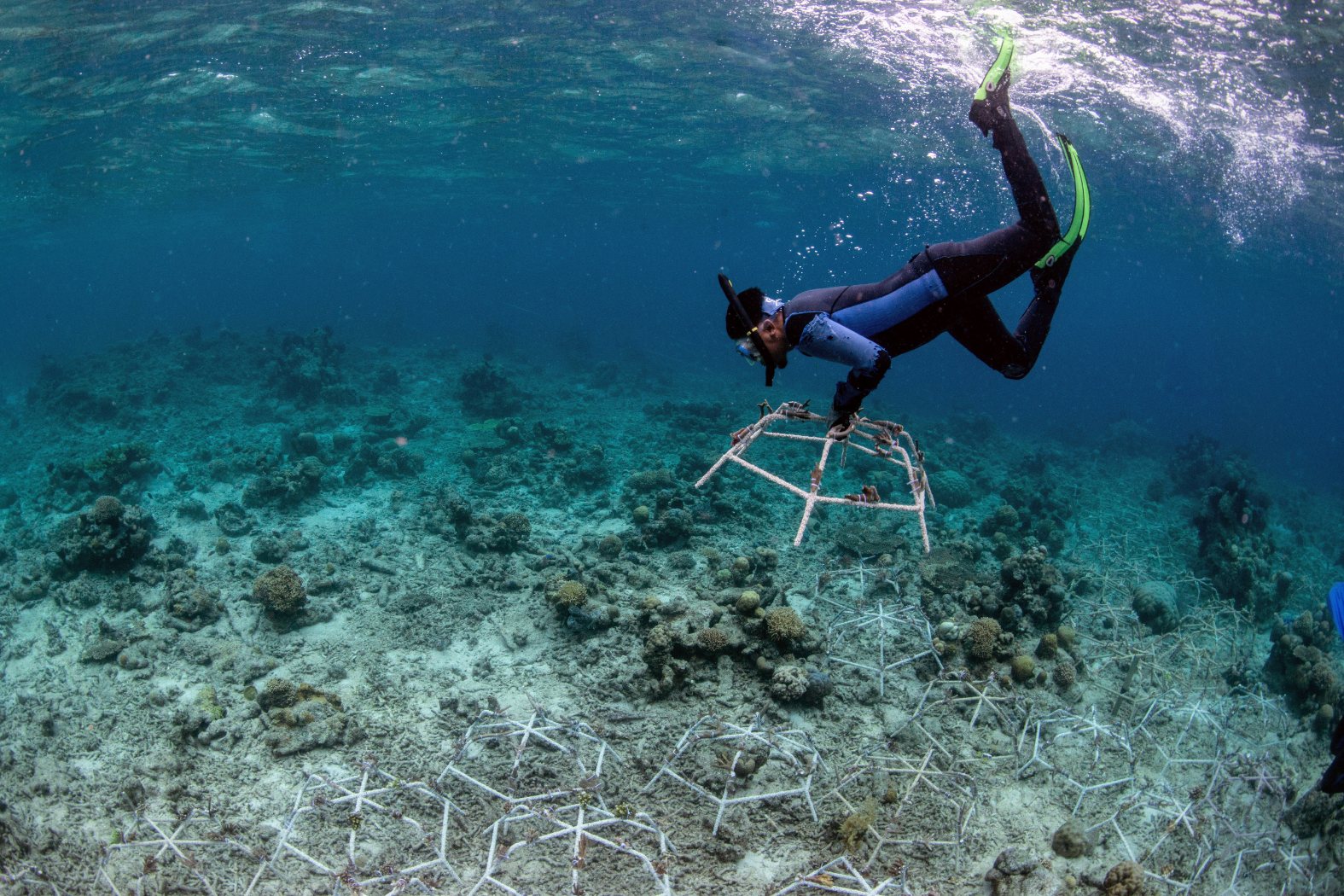Degraded coral reefs can grow as fast as healthy reefs after just four years with the use of sand-coated steel webs known as ‘Reef Stars’, according to new research.
In the 1980s and 1990s, destructive blast fishing in Indonesia destroyed vast areas of fragile coral reef systems. Despite numerous restoration projects in the ensuing years, signs of recovery have been limited.
Now, following a four-year study, researchers from the University of Exeter have found evidence that planting new coral in degraded reefs with the use of ‘Reef Stars’ (sand-coated steel frames) can lead to rapid recovery.
According to the research, published in Current Biology, this network of interconnected frames, transplanted with coral fragments, can result in degraded reefs growing as fast as healthy reefs after just four years.
“The speed of recovery we saw is incredible,” says lead author Dr Ines Lange, from the University of Exeter.
“While reef restoration cannot solve the problem that reefs are severely threatened by climate change, it shows that active management actions can help to boost the resilience of specific reefs, and bring back important functions that are critical for marine life and local communities.”
Measuring reefs
During the study, researchers developed a method to monitor ‘reef carbonate budgets‘ – which is the net production or erosion of a reef over time – using a number of parameters, such as coral cover, coral colony sizes and carbonate production rates, over a range of time periods, to assess the health of the coral.
These carbonate budgets are a key predictor of the reef’s ability to grow and keep up with sea-level rise, to protect coastlines from storms and to provide habitat for marine animals.
“After four years, restoration sites were indistinguishable from nearby healthy reefs in all investigated parameters.”
The team used Mars reef restoration sites (part of the Mars Coral Reef Restoration Programme) to evaluate if and how fast these reef functions return after coral restoration.
They recorded data at various time intervals following the instalment of the Reef Stars, which are used in degraded areas to stabilise loose rubble and kickstart rapid coral growth. During his time, they also analysed degraded and healthy control sites.
Reefs in recovery
The study showed that in the years following coral transplantation, coral cover, coral colony sizes and carbonate production rates tripled, and after four years, restoration sites were indistinguishable from nearby healthy reefs in all investigated parameters.
According to the researchers, this means that after only four years, restored reefs are growing at the same speed as healthy reefs. They provide similar habitat for marine life and offer protection to the adjacent island from wave erosion.
Dr Tim Lamont, from Lancaster University, who initiated the research collaboration, adds: “This is a really encouraging discovery.
“If we can maintain climate conditions that allow for coral survival, it’s possible to restore even very damaged reefs back to healthy, functional systems within relatively short periods of time.”
Researchers involved in the study were keen to point out that, despite the recovery of the transplanted reefs, the community composition of these sites differs from the long-lived, healthy reefs, which are made up of many boulder-like and encrusting corals – a habitat that may be used by larger marine species. The branching corals of the restored reefs may also be less resilient to future heatwaves.
Coral communities
The study was carried out by University of Exeter researchers in collaboration with the Research Center for Oceanography, National Research and Innovation Agency (BRIN) in Indonesia, Mars Sustainable Solutions and Lancaster University.
Co-author of the study Dr Tries Razak, from BRIN Indonesia, says: “Through this research collaboration, I am delighted to observe the highly productive partnership between a distinguished group of international scientists and our team of local scientists and Masters students in Indonesia.
“This collaborative effort not only advances scientific research in Indonesia but also contributes significantly to the capacity building for future generations of Indonesian scientists.”
Dr Lange adds: “It was a great experience to work so closely with a diverse group of international researchers and the skilled local restoration team.
“We all learned a lot from each other.”




The paper “Coral restoration can drive rapid reef carbonate budget recovery” was published in Current Biology by Ines Lange, Tries Razak, Chris Perry, Permas Maulana, Mochyudho Prasetya, Irwan and Timothy Lamont.



